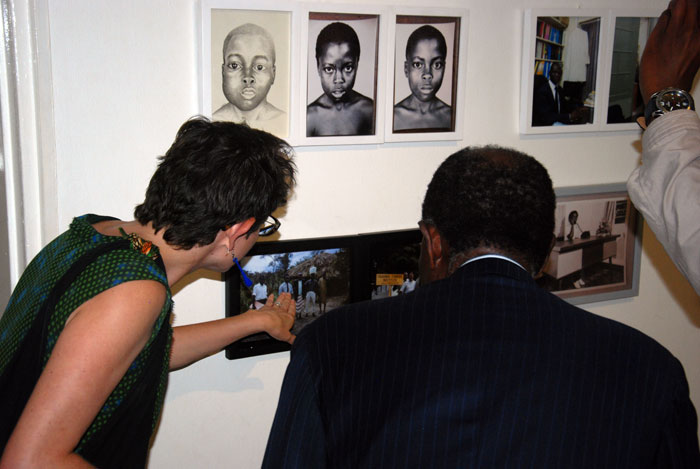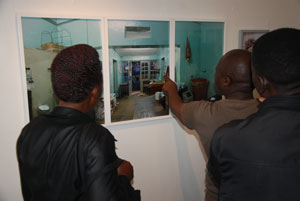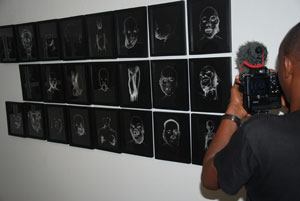
Adventurous `Staying Alive’ exhibit documents the Uganda Cancer Institute
Kampala, Uganda | DOMINIC MUWANGUZI | The story of cancer in Uganda is a touching one. With minimal resources and infrastructure to combat the disease coupled with the swelling numbers of patients admitted to the Uganda Cancer Institute Mulago every day, it is impossible not to feel horrified by the situation. Yet the doctors and their patients together with relatives do not give up in the battle to staying alive.
As the Uganda Cancer Institute celebrated its 50th anniversary this August, it was the perfect moment to look at its past and the bumpy ride to the present.
As part of this effort, History in Progress Uganda (HIPUganda) together with researcher Dr Marissa Mika hosted an exhibition at Afriart Gallery in Kampala. The HIPUganda exhibition showed old and new photographs of the cancer institute .
Also on display was also a poem pinned on one of walls inside the gallery in which the journey is likened to a bus ride in some rural part of Uganda with some passengers throwing up polythene bags assisted by fellow passengers.
Some of the old photographs where picked from an archive by Dr. John Ziegler and Paul Carbone who were part of the Uganda Cancer Institute in the1960s and 70s.
The pioneer doctors who helped in the establishment of the institute and was often concerned about the nature and progress of their patients but also the immediate surroundings of the hospital.
The exhibition also showed new black and white images of children and adults with tumors in the neck , eyes, head, chins and legs produced by Andrea Stultiens of HIPUganda. There’re also medical illustrations by John Nyende and Coleb Butungi on request by HIP Uganda. They are both connected to the medical illustration department of Mulago Hospital. Their drawings are based on historical photographs.
The pictures of the outside environment (outside the patient clinics or ward) are less chilling and offer relief. They show children playing games in the courtyard.

The new photographs show the new cancer ward at the institute after the demolition of the Lymphoma Treatment Centre. These are coloured photographs,and there is more narrative on progression: moments of healing and moving on. Some patients continue to die and the pain that patients endure lingers on.
“I was video-filming this child and their testacles where as big as a ten litre jelly can. There was also this other kid whose eyes were bigger than the Mandazi they were eating. This was spectacular pain and although I am familiar with working with grotesque surfaces, this was too much for me to take in,” says Rumanzi Canon, photographer with History in Progress Uganda.
Doctors too grapple with the challenge of continuity according to Joe Black, from the children cancer ward.
“Our patients are able to move on but we never do. We are dealing with these patients on a routine basis.”
These photographs build a positive visual archive of the disease: showcasing the triumph story of the treatment of cancer despite the little awareness and resources. This resolve to succeed is echoed in the energy and inspiration that led to the mounting of the `Staying Alive’ exhibit in Kampala.


Inspired by a collection of old photographs from Dr. John Ziegler, Marissa Mika, an American Medical historian who had worked at the institute in 2010 contacted Andrea Stultiens of HIPU in 2012 to create an archive that would open up conversations and memories about the institute.
The result is this project that falls under HIPU series of Ekifananyi.

This exhibit emphasises the role played by photography in conveying a message to the audience like the other art platforms. Photography unlike the other art forms is privileged to easily ignite a feeling of belonging and familiarity within the audience. The images on show clearly bring to memory the experience cancer patients go through but also the physical space: the hospital. In juxtaposing the old and new in the exhibit, HIPU invites the public to dialogue on issues of continuity, humanity and the complexity of building relations with doctors, patients and their relatives.
`Staying Alive’ , the book, is a collaborative project between American medical historian and Anthropologist, Marissa Mika and History in Progress Uganda.
RELATED STORIES
#StayingAlive book launched as #Uganda #Cancer Institutue celebrates #UCI50 https://t.co/7XQuEDQOpj pic.twitter.com/LM2cHN2bLL
— The Independent (@UGIndependent) August 21, 2017
Cancer Institute struggles on 50 years later https://t.co/JwaA7p9TK2 pic.twitter.com/V2prGt2Oz9
— The Independent (@UGIndependent) August 28, 2017
 The Independent Uganda: You get the Truth we Pay the Price
The Independent Uganda: You get the Truth we Pay the Price




Well, am not sure where to begin here. There is so much that is misunderstood in this article, and while this exhibition is not and should not be about me, I am the one who curated it, initiated it (based on work done by Marissa Mika), and made all the photographs made in 2012 that are in the exhibition. So, let me list some of the obvious:
– It was not the gallery that put up the show, but HIPUganda / me. We hired the gallery as a space.
– The photographs were not ‘picked’ from Ziegler’s archive but partly in his collection, partly in dr. Carbone’s
Where Marissa Mika found them.
– The new photographs were all made by me.
– The medical illustrations were made by John Nyende and Coleb Butungi on my request. They are both connected to the medical illustration department of Mulago Hospital. Their drawings are based on historical photographs
– The photographs I made show mainly the old LTC ward BEFORE demolition
Andrea Stultiens (with Rumanzi Canon, whose name is misspelled above) initiator of HIPUganda
Got your email. When you next visit the site, we will have made the corrections.
well am delighted because my dad is right there in one of them am so happy.thankyou thankyou God Blessyou